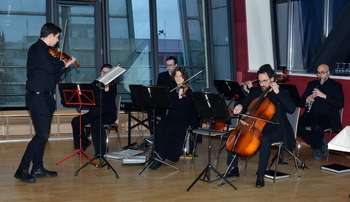Heitfeld award 2024 for the M.Sc. thesis of Anton Ziegon
Posted on 2024/12/06

Every year, the Professor Dr. Karl-Heinrich Heitfeld Foundation honors Master graduates and doctorates in the field of geosciences at RWTH Aachen University for outstanding achievements (Heitfeld Award). The foundation was established in 1995 by Professor Heitfeld (former professor in engineering geology) and his wife. At the 30th award ceremony on December 6, 2024, the M.Sc. thesis of former GIM member Anton Ziegon titled “Minimum entropy constraints for 3D structurally-coupled joint inversion of near-surface geophysical data acquired at the Rockeskyller Kopf, Germany“ was awarded. In the frame of the IDEA League M.Sc. program in Applied Geophysics, Anton Ziegon implemented, analyzed and discussed a novel joint inversion algorithm for the combination of multiple geophysical methods based on the concept of minimum structural entropy constraints.
Unfortunately, Anton could not attend the ceremony in person, as he is currently working as a PhD researcher at the University of Calgary in Canada. Florian Wagner gave the award presentation on his behalf. Highlights of the ceremony included the presence of Prof. Heitfeld shortly after his 100th birthday, celebratory speaches by the rector Prof. Ulrich Rüdiger, dean Prof. Peter Kukla and vice dean Prof. Klaus Reicherter, as well as a keynote presentation on the Einstein telescope by Prof. Florian Amann.
Anton’s M.Sc. work was also recently published in the journal of Applied Geophysics. Congratulations Anton!
-
Minimum entropy constrained cooperative inversion of electrical resistivity, seismic and magnetic data
2024 |
Journal of Applied Geophysics, doi:10.1016/j.jappgeo.2024.105490
RWTH Publications PDFNote: This publication resulted from the first M.Sc. graduate of GIM – Anton Ziegon.Abstract
Geophysical methods are widely used to gather information about the subsurface as they are non-intrusive and comparably cheap. However, the solution to the geophysical inverse problem is inherently non-unique, which introduces considerable uncertainties. As a partial remedy to this problem, independently acquired geophysical data sets can be jointly inverted to reduce ambiguities in the resulting multi-physical subsurface images. A novel cooperative inversion approach with joint minimum entropy constraints is used to create more consistent multi-physical images with sharper boundaries with respect to the single-method inversions. Here, this approach is implemented in an open-source software and its applicability on electrical resistivity tomography (ERT), seismic refraction tomography (SRT), and magnetic data is investigated. A synthetic 2D ERT and SRT data study is used to demonstrate the approach and to investigate the influence of the governing parameters. The findings showcase the advantage of the joint minimum entropy (JME) stabilizer over separate, conventional smoothness-constrained inversions. The method is then used to analyze field data from Rockeskyller Kopf, Germany. 3D ERT and magnetic data are combined and the results confirm the expected volcanic diatreme structure with improved details. The multi-physical images of both methods are consistent in some regions, as similar boundaries are produced in the resulting models. Because of its sensitivity to hydrologic conditions in the subsurface, observations suggest that the ERT method senses different structures than the magnetic method. These structures in the ERT result do not seem to be enforced on the magnetic susceptibility distribution, showcasing the flexibility of the approach. Both investigations outline the importance of a suitable parameter and reference model selection for the performance of the approach and suggest careful parameter tests prior to the joint inversion. With proper settings, the JME inversion is a promising tool for geophysical imaging, however, this work also identifies some objectives for future studies and additional research to explore and optimize the method.
Cite as
Ziegon, A.H. and Boxberg, M.S. and Wagner, F.M. (2024): Minimum entropy constrained cooperative inversion of electrical resistivity, seismic and magnetic data. Journal of Applied Geophysics. https://doi.org/10.1016/j.jappgeo.2024.105490











